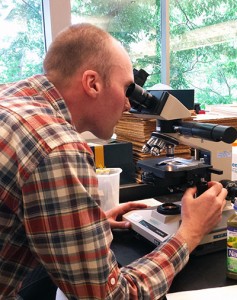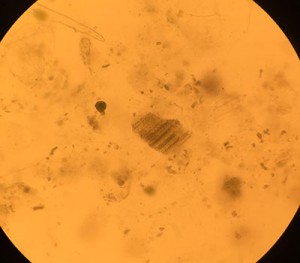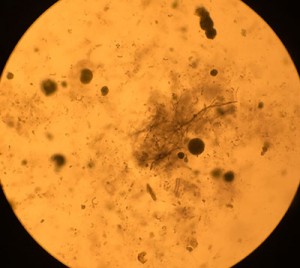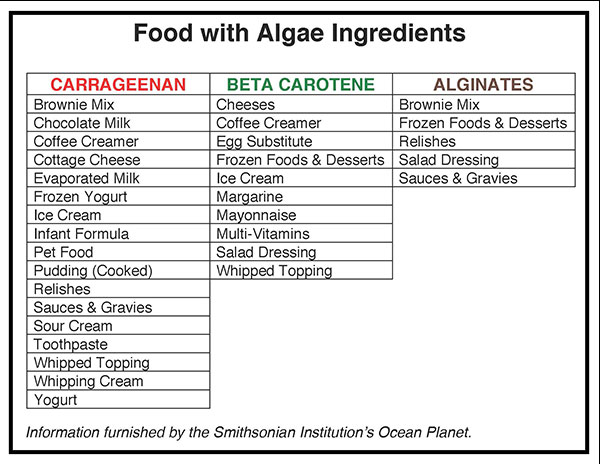Algae: Under the Microscope and In Your Food
Posted in Adult Education on May 28 2015, by Plant Talk

Although we sometimes can’t see, smell, or taste them, many foods we eat and products we use contain algae, a group of oxygenic photosynthesizers—plants that make oxygen and perform photosynthesis, but are not part of the most familiar subkingdom of green plants.
I wanted to take a look at the itty bitty algae in a popular beverage, Naked “Green Machine” juice, which lists algae as ingredients, so I paid a visit to Robin Sleith, a research graduate student working on his Ph.D. in plant science in the Pfizer Laboratory. His research focuses on algae species, their lineage, and their relationships to land plants.
Intrigued by the prospect, Robin led me to the mycology lab, where they conduct experiments on algae and fungi. As he opened the bottle of juice, he let me know that it’s now considered science, not food, so there was no chance of me consuming it later.
He added a droplet of Green Machine to a slide, and slid it onto the compound microscope. At first, he was skeptical that we would see much at all, because Naked juice lists only 1,335 mg of Spirulina, a type of blue-green algae; 400 mg of Chlorella, another blue-green algae; and another 50 mg of generically described blue-green algae in its ingredients. In a 15.2 fluid-ounce bottle of juice, those amounts are nearly negligible. Robin wasn’t sure the juice would appear as anything more than a great, green glob under the microscope.
To our excitement, we saw algae—lots of it—at just 10-20x power.

We saw what might have been the Spirulina, which appeared to have lost all their pigment, or spiral tracheids, a part responsible for water transport in land plants. Usually Spirulina appear as individual, curly strands, but when clumped together like they did under the microscope, they looked a bit like dry ramen noodles.
There were Chlorella, a true green, freshwater algae, which are spherical and darker green.
To add a bit of mystery, the microscope also showed filamentous blue-green algae, which were massed together in random patterns on the slide—perhaps part of the 50mg of the vaguely described blue-green algae.
“The things that are in this juice are sort of exceptions to the rule in terms of algae in our food day-to-day, unless you’re eating a diet like Japanese cuisine,” Robin said. “Mostly, diet pills that work that work are made with algae derivatives.”
Such algae derivatives are carrageenan, alginates, and Beta Carotene.

Carrageenan is a generic term of extracted compounds from species of red algae. They are used to stabilize and hold together foods, cosmetics, medicines, and more. Brown algae provide us with alginates, which make water-based products creamier, thicker, and more stable over variances in temperature, pH, and time, like sauces and gravies. Green-algae-derived Beta Carotene, a natural pigment, is used as a yellow-orange food coloring in products like coffee creamers, margarine, and egg substitutes.
Algae are beneficial because of their high concentration of protein and other dense nutrients. However, to get a lot of these benefits, one would have to consume a very large amount of it, which is why we don’t tend to make seaweeds a staple of our diets, choosing instead to eat other foods with higher levels of the same nutrients. Algae are in almost everything we eat, because it is the base of many food chains, especially aquatic ones. For example, fish rich in fatty acids get those nutrients because they eat fish that eat a lot of plankton.
And algae itself are a bit of a mystery still, which is why they’re such a focus of the molecular systematics research conducted at Pfizer.
“As we figure out what algae really are, we’re learning not to think of it as a taxonomic distinction, but as a functional distinction,” Sleith said.
After my experience in the lab, I’ve come to think of algae as a taste of the unknown. “Green Machine,” which Naked says “looks weird, tastes amazing,” does, in fact, look weird, but is even more fantastically strange upon a closer, microscopic look.
 Robin Sleith introduces students in the Adult Education program to algae at the multi-cellular level in his upcoming Botany class, “The Universe of Algae,” on June 5, part of the Plant Whisperers series, in which the Garden’s scientists, including leading researchers, authors, and lecturers in plant research and conservation give students the tools to discover, understand, and preserve Earth’s botanical diversity. Learn more.
Robin Sleith introduces students in the Adult Education program to algae at the multi-cellular level in his upcoming Botany class, “The Universe of Algae,” on June 5, part of the Plant Whisperers series, in which the Garden’s scientists, including leading researchers, authors, and lecturers in plant research and conservation give students the tools to discover, understand, and preserve Earth’s botanical diversity. Learn more.

